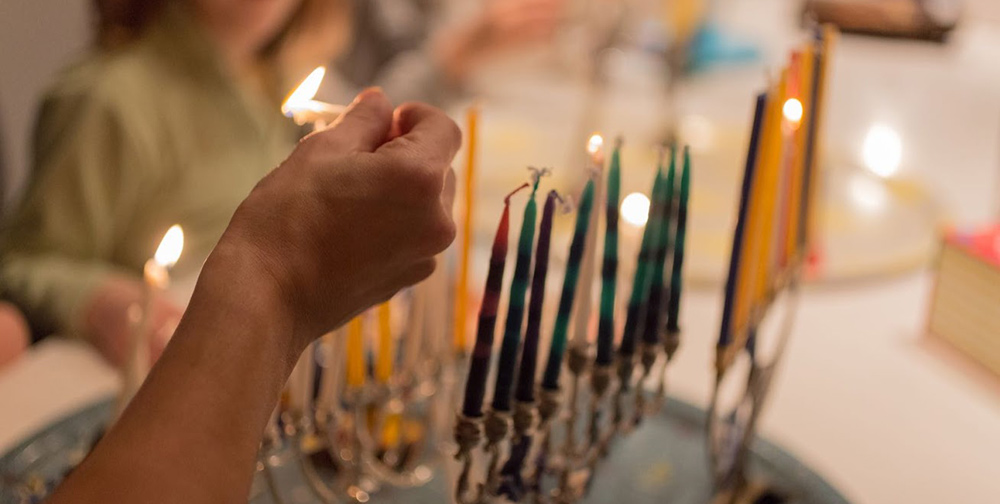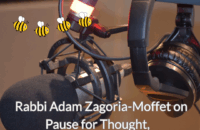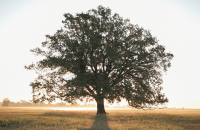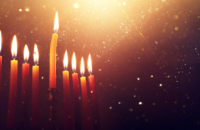Yom Ha’atzmaut

What is the correct greeting on Yom Ha’atzmaut? Should we say chag sameach – happy holiday, as we do on the three major holidays: Pesach, Shavuot, and Sukkot? Or should we give the non-holiday greeting of Yom Ha’atzmaut sameach — Happy Independence day?
Really, it depends on whether we consider Yom Ha’atzmaut a national holiday or a religious holiday, and it depends on the meaning of the word chag.
I like trying to figure out the etymolgy of words: chag is similar to the Hebrew word for dialing the phone (l’chayeg) and a machog is a hand on a clock. I reasoned that the chet – gimmel root probably referred to a dial, or something that goes around. A chagura, for example, is a belt that circles you. I wondered if there was any connection to the word chag.
It occurred to me that the chagim are part of the cycle of the year. My biblical dictionary (Brown Driver Briggs Hebrew Lexicon) added that sacred dances – probably done in circles – were part of the chag ritual. And it occurred to me that, similarly, the Hajj is both the Islamic holiday as well as a time when Muslims circle around the black rock in Mecca.
Since each year, like clockwork, Yom Ha’atzmaut comes after the emotional roller coaster of Yom Hashoah and Yom HaZikaron. In a sense it is a chag because it has become part of our Jewish cycle of the calendar year.
Is it a national holiday or a religious holiday? Of course, it has been celebrated as a national holiday every year since 1949.
Yet our religious spirit was stirred in the founding of this State. In 1949 the Israeli Chief Rabbinate decided on a festive evening and morning service. These included the pesukei-d’zimra (opening morning service prayers) for Shabbat, Nishmat, Hallel, and the haftarah, Isaiah 10:32–11:12, but – and here’s the kicker – without the brachot blessings before Hallel and without the brachot before and after the haftarah reading. It was as if they were agreeing to do a little “show” Hallel and haftarah, like a chag drill. The Rabbinate’s decision sent a message that you couldn’t add another religious holiday and that a developing Jewish history was over.
But the modern religious community in Israel let out a collective “uh-uh, no way”. We had prayed for a thousand years to be back in our homeland and the miracle of being in Jerusalem, after more than a millenium of saying le’shanah habah bi’yerushalayim, was too great to play it off as a minor event. Between the 1950s and 70s, the Hallel and Torah reading with full blessings were added and authorized several senior rabbis and the Chief Rabbinate Council.
If your heart beats as mine does, then you don’t need someone to tell you that living in Israel is part of our religious experience. We not only have the option, we have the responsibility to be part of the developing history of Judaism – and that includes marking new days of tragedy and celebrating new holidays. That’s why we say Hallel on Yom Ha’atzmaut.
In the classic Israeli song “Shir LaShalom” we sing “kan lo yo’ilu, lo shirei hanitzahon, velo shirei hallel”: here, neither the victory cheer, nor songs of hallel will help. I have to disagree. Our cry in each generation to return to Zion is exactly what helped bring us back to this Land. I pray for peace because I know the power of prayer. You can bet I’m going to sing Hallel now that we’ve made it. The song continues “al tilhashu tfila”: don’t whisper a prayer because it’s not going to help. I’ll tell you that my Jewish heart answers that instead of whispering, I sing it loud to the heavens: thank God for this nation which is ours. Thank God for a Jewish homeland.
Yom Ha’atzmaut is a great day to remind ourselves to thank God. Thank God for our own military, our own police force, our own judges and our own government. We all know they could be better – but thank God they are ours.
In Israel the problems are ours. We are the ones to make this country sink or rise to its great potential. Am Yisrael Chai and chag sameach.
Rabbi Paul Arberman lives in Modiin, Israel and is the rabbi of Hatch End Masorti Synagogue.




